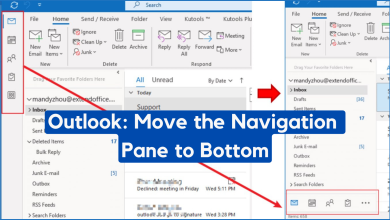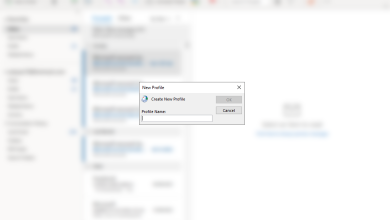‘Links not opening on Outlook 2016 and Earlier Versions’ [7 Fixes]
A lot of users are encountering problems when trying to open links (hyperlinks) from inside an Outlook Email. Most affected users report that this particular issue occurs after a large Windows 10 update or after they completed the upgrading process from an older Windows version to Windows 10.
After trying to replicate the issue and looking at various user reports, it seems like most of the time the problem occurs either due to the default browser or because of a bad office installation. Even though the Can’t Open Links in Outlook is mostly encountered on Windows 10, it’s also reported on Windows 7 and Windows 8 (8.1), especially with Windows Office 2010.
If you’re currently struggling with the same issue, this article will provide you with the best troubleshooting guides capable of resolving the issue. Please follow the methods below in order until you encounter a fix that takes care of the issue for you. Let’s begin!
Method 1: Repairing the Office Installation
First things first, let’s make sure that the issue is not caused by a bad Office installation. Sometimes your Microsoft Outlook program might misbehave due to a glitch or a bad Office Installation. Some users have managed to resolve the issue after using the Programs and Features window to repair the Microsoft Office Suite.
Here’s a quick guide on attempting to fix the can’t Open Links in Outlook by repairing the Microsoft Office Installation:
- Press Windows key + R to open up a Run box. Next, type “appwiz.cpl” and hit Enter to open Programs and Features.

- Inside Programs and Features, scroll down through the application list and locate the Microsoft Office associated with the Outlook version that is giving you problems.
- Right-click on your Microsoft Office version and choose Change.

- In the Microsoft Office Repair window, select the Repair toggle si Continue.

- Follow the on-screen prompts to start the repair process and wait for it to complete.
- Restart your computer and see if the issue is resolved at the next startup.
If you’re still unable to open links (hyperlinks) inside Microsoft Office, continue down with the next method below.
Method 2: Changing the default web browser to Internet Explorer or Microsoft Edge
Since this particular issue is most often caused by the default browser, there’s a decent chance that you might be able to resolve the issue by simply changing the default browser.
As it turns out, older Outlook versions are known to refuse to open hyperlinks or even crash when the default web browser is not set to Internet Explorer (IE) or Microsoft Edge. Most of the time, issues of this kind are encountered with Microsoft Office 2010 or lower that use a 3rd party browser (Chrome, Opera, Firefox, etc.).
Note: If you are using a third-party browser and you’re not interested in switching to a built-in alternative, jump straight to Method 3.
If you’re using a third-party browser as the default choice, here’s a quick guide on changing the default browser in an attempt to solve the “can’t open Outlook links” issue:
- Press Windows key + R to open up a Run box. Then, type “control” and hit Enter to open Control Panel.
- Inside Control Panel, click on Default Programs.
- Inside Default Programs, click on Set your default programs.
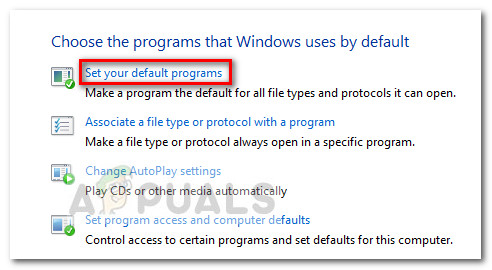
- In the Default apps window, scroll down to the Web browser section and click on the application that is currently set as the default. Next, either select Microsoft Edge or Internet Explorer from the list.

- Once you change the default browser to Internet Explorer or Microsoft Edge, restart your computer.
- At the next startup, open Outlook and see if you are able to open links from it. If the issue is still not resolved, continue down with the next method below.
Method 3: Update Firefox to the latest version available (if applicable)
If you are using Firefox as the default browser, you might want to double-check if you are using the latest version available. There is a bug with Firefox version 58 triggered by the Outlook.com layout that causes links to become unopenable. Because the issue is fairly old by now, Mozilla has already addressed this issue with a hotfix included with Firefox version 60.
Note: If updating to the latest Firefox build is not an option (due to extension incompatibility or other issues), skip straight to Method 4.
Here’s a quick guide on making sure that Firefox is updated to the latest version:
- Open Firefox and click on the action button in the top-right corner.
- From the action menu, go to Help > About Firefox.
- If a new update is available, click the Restart to update Firefox button and wait for the browser to reboot with the latest build.

- Click Yes at the UAC (User Account Control) regarding the Firefox Update Software.
- Once you manage to update Firefox to the latest version, reboot your computer.
- At the next startup, see if the issue has been resolved by clicking on a link inside Microsoft Outlook. If you’re still unable to open hyperlinks inside Outlook or this method was not applicable, continue with the next method below.
Method 4: Changing a Firefox Setting (if applicable)
If you’re using some add-ins that are not compatible with the latest Firefox version, you might not be inclined to update to the latest version available. Luckily, there is one workaround that will make links usable again even without updating to the latest build.
Some users have managed to make links usable again inside Outlook by modifying a Firefox setting. Here’s what you need to do:
Note: Keep in mind that the steps below are only applicable on Firefox versions that are older than Firefox version 60. If you have Firefox version 60 or newer, you won’t be able to advance past step 4.
- Open a new tab inside Firefox.
- In the navigation bar at the top, type or paste “about:config” and hit Enter.
- Click the I accept the risk! button to enter the Advanced Settings of Firefox.
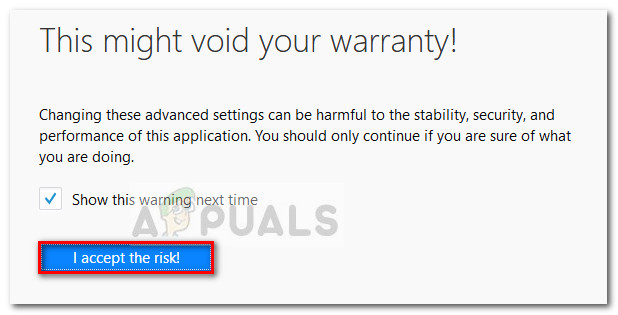
- Use the search box at the top of the Advanced Settings list and type “stylo”.
- Next, double-click on layout.css.stylo-blocklist.enabled and change the default value from False to True.
- Then, double-click on layout.css.stylo_blocklist.blocked_domains and set the default value to live.com.
Note: If you using Office 365 instead of live.com to view your mail, use office.com (or office365.com) instead of live.com. - Close and re-open Firefox to see if the issue has been resolved. If you’re still encountering the same problem, continue down with the next method below.
Method 5: Altering the .html and .htm values via Registry Editor
Your organization policies can also be responsible for preventing you from opening links. Some users have managed to resolve the issue by altering the values of .html and .htm values via Registry Editor.
There are two ways that you can follow in order to do this. You either create a registry fix yourself and run it to operate all the modifications at once or you do the modifications with the help of an elevated Command Prompt. Feel free to follow whichever guide seems more convenable to you:
Creating a. REG file
- Right-click on a free space in your desktop and choose New > Text Document and name it whatever you want.
- Open the newly created text document and paste the following text inside:
Windows Registry Editor Version 5.00Windows Registry Editor Version 5.00 [HKEY_CLASSES_ROOT\.html] @="htmlfile" "Content Type"="text/html" "PerceivedType"="text" [HKEY_CLASSES_ROOT\.htm] @="htmlfile" "Content Type"="text/html" "PerceivedType"="text" [HKEY_CLASSES_ROOT\.shtm] @="htmlfile" "Content Type"="text/html" "PerceivedType"="text" [HKEY_CLASSES_ROOT\.shtml] @="htmlfile" "Content Type"="text/html" "PerceivedType"="text" [HKEY_LOCAL_MACHINE\SOFTWARE\Classes\htmlfile\shell\open\command] @="\"C:\\Program Files\\Internet Explorer\\IEXPLORE.EXE\" -nohome"
- Once the code is in place, go to File > Save as and change the extension from .txt to .reg and hit the Save button.
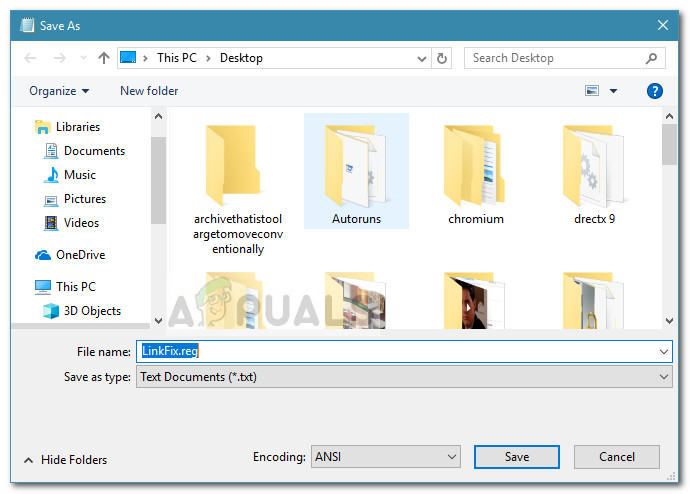
- Navigate to the location where you previously saved the file and double-click on it to open. Then, hit Yes at the UAC prompt to allow the application to make the required modifications in your Registry files.
- Reboot your computer and see if the issue has been resolved at the next startup.
Using an elevated Command Prompt
- Press Windows key + R to open up a Run box. Then, type “cmd” and hit Ctrl + Shift+ Enter to open up an Elevated Command prompt with administrative privileges.

- Inside the elevated Command prompt, copy and paste the following commands and hit Enter:
REG ADD HKEY_CURRENT_USER\Software\Classes\.htm /ve /d htmlfile /fREG ADD HKEY_CURRENT_USER\Software\Classes\.html /ve /d htmlfile /f REG ADD HKEY_CURRENT_USER\Software\Classes\.shtml /ve /d htmlfile /fREG ADD HKEY_CURRENT_USER\Software\Classes\.xht /ve /d htmlfile /f REG ADD HKEY_CURRENT_USER\Software\Classes\.xhtml /ve /d htmlfile /f
- Close the elevated Command Prompt and restart your computer. See if the issue has been resolved at the next startup.
Method 6: Resetting Internet Explorer
Internet Explorer is often used by programs to browse the internet instead of any other browser installed on the computer and if there is a problem or glitch with the internet explorer, the whole searching process is halted. Therefore, in this step, we will be resetting internet explorer to deal with this issue. For that:
- Press Windows + R to open the Run prompt.
- Type in “Inet.cpl” and press “Enter” to open the internet properties window.
- Click on the “Advanced” tab and click on the “Reset” button.

- Check the “Delete Personal Settings” option in the new window and then again select “Reset” to implement your selection.

- Restart your computer and check to see if the issue still persists.
Method 7: Enabling Internet Explorer
In some cases, the internet explorer might have been disabled from the control panel. Therefore, in this step, we will be enabling it from the classic control panel interface and then check if this issue is fixed. In order to do that:
- Press “Windows” + “R” to open the Run prompt.
- Type in “Control panel” and then press “Enter”.
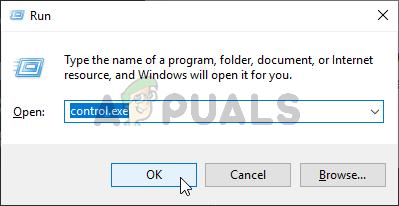
Running Control Panel - Click on “Programs” and then select “Turn Windows Features On or OFF”.

- In here, make sure that the “Internet Explorer 11” box is checked.
- If not, check it and then save your changes by clicking on “OK”.
- Check to see if the issue persists.
Note: If nothing else works, first try to create a new user account and check if links work in that and if that doesn’t work, try to restore your computer to a previous build.

